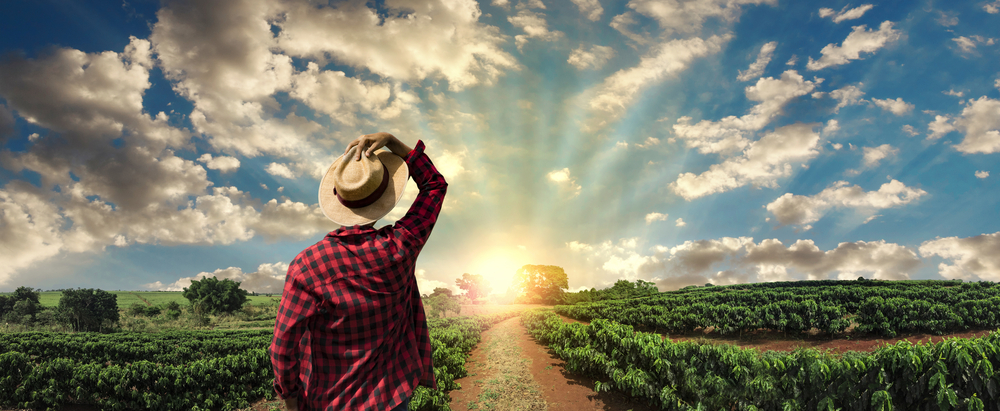For U.S. Farmers, Sustainability Is the Future of Profitability
How new technologies are helping organic farms increase their margins—and propelling sustainability into the mainstream
In farm country, “climate change” can be a dirty word.
Whether you’re standing in a chilly shop in Nebraska, sweltering in a Virginia bean field, or walking a California vineyard, mentioning greenhouse gases or rapidly changing global weather patterns is a good way to get a farmer to clam up. Maybe they’ll shout you down, or show you the door.
But whether farmers are willing to discuss it or not, climate change is happening. Though they haven’t been embraced by all farmers, efforts to adapt agriculture to a hotter, drier, less predictable world are already underway.
This climate divide is (by far) not the only split in agriculture. There’s organic versus conventional. Small versus large. Selling produce at the elevator versus at the farmers market. Federal subsidies or none. Few crops versus many. Till versus no-till.
Farmers I’ve met find themselves split on many issues. Many more fall on both sides, depending on who they’re talking to or how much they’re itching for a good debate.
Underneath it all, a perceived fault line seems to run through these issues: You’re either a small, organic farmer who grows many crops and sells them at the farmers market, or you’re a big, conventional, elevator farmer who grows just a few commodities and participates in federal programs. But that perception rarely holds true. For example, most organic produce available is grown on large farms that produce very few crops, and many farmers who use conventional fertilizer and pesticides are relatively small and grow a variety of crops.
But stereotypes don’t come from nowhere. In my experience with big, conventional farms, ideas around environmental sustainability are not only a low priority, they’re simply not discussed. Smaller, consumer-connected farmers are more likely to focus on sustainability issues, even if only as a marketing feature of their produce (but usually also because they tend to employ people who have returned to the land specifically for environmental reasons). Many of the farmers who care the most about sustainability can’t afford to put it into practice. Raising plants and animals in a way that benefits (or at least doesn’t harm) the earth, the farm workers, the animals, and the consumers is incredibly expensive. And Americans don’t like to pay a lot for food.
There’s a persistent perception that bigger, more profitable farmers lack the will to adopt climate-smart practices. But, at least right now, the sheer scale of work to be done — and the razor-thin margins of even the most profitable U.S. farms — makes it nearly impossible to significantly invest in sustainability.
Over the last few years, the divide between these two agriculture groups — big and conventional vs. small, organic, and sustainable — has been shrinking. Profitable farmers are marching steadily toward sustainability goals, embracing ideas around reduced tillage, adaptive grazing, and cover cropping. They’re proving that it pays to farm in a way that preserves resources. At the same time, farmers who returned to the land to make a difference are embracing the reality that you can’t save your patch of dirt if it doesn’t make enough to put food on the table, and they’re making inroads toward profitability.
Socially, this is a fascinating phenomenon — and if there’s a figurative watering hole on the Serengeti of agriculture, it’s something called “AgTech.” AgTech can be a slippery concept; smartphone apps for farmers and fancy automation tools come to mind, but it can encompass much more than that. AgTech is all of the new methods, skills, and tools driven by science that help producers farm better. It’s everything from the most advanced A.I. to practices like planting cover crops.
Technology, it seems, holds the potential to make sustainability not only profitable but more profitable than conventional farming methods. Ideally, this will create a bridge between financial and environmental sustainability. Whether it’s using sensors, software, and aerial imagery to better understand crops or using advanced biology to find and prove non-antibiotic growth hormones, no subject attracts the smartest, most pragmatic, and most future-oriented farmers quite like a new piece of farming technology.
AgTech is the bright spot that’s reconnecting American agriculture. It’s bringing these two camps together and uniting them under the shared goal of profitable sustainability.
This development is exciting, but it’s not unexpected. There’s something about farm life, about the isolation and vulnerability to the elements that—no matter where you’re from or what you’ve done before—gives you the unshakeable sense that you’ll do what needs doing, helping your neighbor as much as you can.
This is not to say that AgTech is a panacea. It’s certainly not—and there’s a good amount of pointless, expensive AgTech out there. But farmers on both sides of some pretty thorny issues are finally finding a common language in technology. The more these groups interact, the more likely they are to share ideas.
The next time you hear someone pushing a “you can’t afford not to” argument on a conventional farmer, or someone trying to argue down the price of pasture-raised beef at the farmers market, remember: Farmers aren’t foolish. You can “afford not to” if you don’t have money in your bank account to pay for cover crop seed. The price of truly responsible food is high — really high — and not comparable to what you pay in the supermarket. Farmers must be able to afford their environmental stewardship. Someone, or something, has to pay for it. AgTech is one way to, over time, lower that cost.
If we want to reach a sustainable world more quickly, empowering farmers in the AgTech equation would be one way to do it. Farmers shouldn’t just be testing and adopting new tech, they should be designing and investing in it. The natural bridge forming between agricultural technology and farmers themselves must be exploited for the benefit of all of us.

